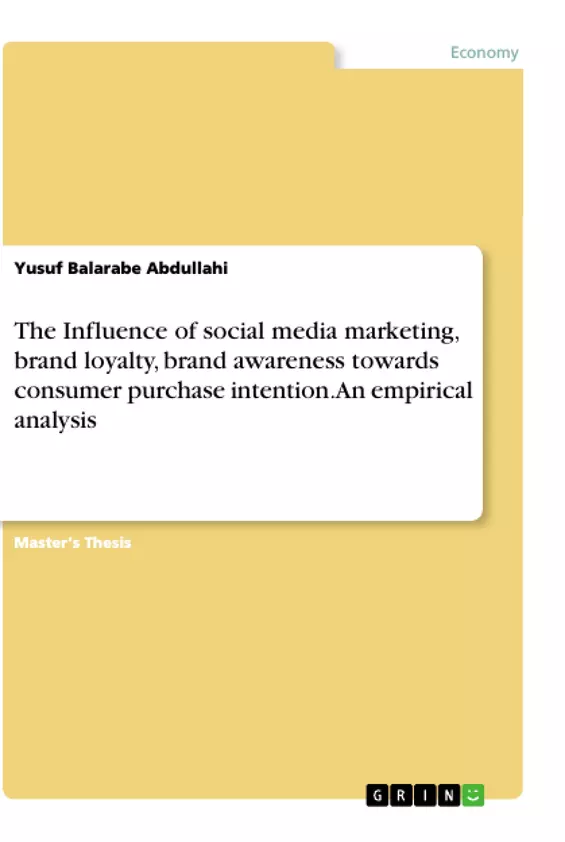The reason for this research is to distinguish and look at consumers' purchase intention in Malaysia through social media marketing, brand loyalty and brand awareness. Other than that, this research rushes to discover the relationships between social media marketing, brand awareness and electronic word of mouth towards brand loyalty among the consumers in Malaysia inciting purchase intentions.
Consumers purchase intention has developed with the help of the social media marketing, and progressively replacing the customary marketing techniques. The marketing methodology is based on social media platforms where consumers are currently looking for information about an item or service, and others encounters before resolving to purchase the item or service. The sharing of the brands, item surveys, and clients' encounters are a piece of the electronic word of mouth where data is transmitted and gotten over the web.
With the impact of electronic word of mouth and social media marketing, it has an effect to the brand loyalty, and in the end towards purchase intentions. This study endeavors to study the effect of social media marketing, brand loyalty, and brand awareness towards purchase intentions. Two hundred questionnaires were collected toward the end of the review inside Malaysia. Five hypotheses were produced and tested.
Inhaltsverzeichnis (Table of Contents)
- INTRODUCTION
- Background
- Problem Statement
- Table of Contents
- Research Objectives
- General Objective
- Specific Objectives
- Research Questions
- Significant of Studies
- Term of References
- Overview of the Report
- Summary
- LITERATURE REVIEW
- Introduction
- Social Media and Social Media Marketing
- Social Media
- Social Media Marketing
- Brand Loyalty
- Word of Mouth and Electronic Word of Mouth
- Word of Mouth
- Electronic Word of Mouth
- Differences between WOM & eWOM
- Purchase Intention
- Previous Empirical Studies
- Social Media Marketing to Brand Loyalty
- Electronic Word of Mouth to Brand Loyalty
- Social Media Marketing to Purchase Intention
- Brand Loyalty to Purchase Intention
- Electronic Word of Mouth to Purchase Intention
- Theoretical Framework
- Theory of Reasoned Action
- Theory of Planned Behaviour
- Conceptual Framework
- Hypotheses Developments
- Social Media Marketing and Brand Loyalty
- Electronic Word of Mouth and Brand Loyalty
- Social Media Marketing and Purchase Intention
- Brand Loyalty and Purchase Intention
- Electronic Word of Mouth and Purchase Intention
- Summary
- METHODOLOGY
- Introduction
- Research Design
- Research Approach
- Research Methodological Choices
- Population and Sampling
- Sampling Size
- Pilot Study
- Data Collection Methods / Instruments
- Construct Measurement
- Data Scale of Measurement
- Variables
- Reliability Testing
- Statistical Testing
- Linear Regression
- Multiple Regression Analysis
- Mediation Effect Analysis
- Summary
- RESULTS
- Introduction
- Respondent Demographics
- Descriptive Analyses
- Reliability Analysis
- Linear Regression Analysis
- Multiple Regression Analysis
- Mediation Effect Analysis
- Summary
- DISCUSSION
- Introduction
- Findings through Descriptive Analysis
- Discussion of Major Findings
- H1: Social media marketing will have significant positive influence on consumers' brand loyalty
- H2: Electronic word of mouth will have significant positive influence on consumers' brand loyalty
- H3: Social media marketing will have significant positive influence on consumers' purchase intention
- H4: Brand loyalty will have significant positive influence on consumers' purchase intention
- H5: Electronic word of mouth will have significant positive influence on consumers' purchase intention
- Mediating Effects
- Implications
- Limitations of Study
- Recommendations for Future Research
- Summary
Zielsetzung und Themenschwerpunkte (Objectives and Key Themes)
This report aims to investigate the impact of social media marketing and electronic word of mouth on brand loyalty and purchase intention. The research focuses on the relationships between these variables and explores their mediating effects on consumer behavior.
- The influence of social media marketing on brand loyalty
- The influence of electronic word of mouth on brand loyalty
- The influence of social media marketing on purchase intention
- The influence of brand loyalty on purchase intention
- The influence of electronic word of mouth on purchase intention
Zusammenfassung der Kapitel (Chapter Summaries)
- Chapter 1: Introduction This chapter introduces the research topic, outlining the background, problem statement, and research objectives. It also defines key terms and provides an overview of the report's structure.
- Chapter 2: Literature Review This chapter presents a comprehensive review of existing literature related to social media marketing, brand loyalty, electronic word of mouth, and purchase intention. It examines previous empirical studies and theoretical frameworks relevant to the research topic.
- Chapter 3: Methodology This chapter details the research design, approach, and methods used to conduct the study. It includes information on the population, sampling, data collection instruments, and statistical analyses.
- Chapter 4: Results This chapter presents the findings of the study, including descriptive analyses, reliability testing, and regression analyses.
- Chapter 5: Discussion This chapter discusses the study's findings, their implications, and limitations. It also provides recommendations for future research.
Schlüsselwörter (Keywords)
This report focuses on the key areas of social media marketing, electronic word of mouth, brand loyalty, and purchase intention. The research examines the relationships between these factors and explores their influence on consumer behavior.
- Citation du texte
- Yusuf Balarabe Abdullahi (Auteur), 2018, The Influence of social media marketing, brand loyalty, brand awareness towards consumer purchase intention. An empirical analysis, Munich, GRIN Verlag, https://www.grin.com/document/996400



